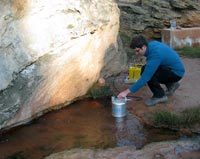News
Australia-China science exchange improves CO2 monitoring technique
Published:8 January 2015

Geoscience Australia geologist Ivan Schroder
takes CO2 measurements from a natural CO2
seep in the highlands of Qinghai, western China
A recent science exchange hosted by the Chinese Geological Survey has given Australian and Chinese researchers a chance to share expertise in greenhouse gas monitoring technologies.
Carbon capture and storage (CCS) is a key part of Australia's strategy for developing low emissions technologies for fossil fuels. The process involves capturing carbon dioxide (CO2) from industrial sources such as power plants, then compressing and injecting it deep underground for safe and permanent geological storage.
Detecting and measuring potential leakage from storage sites is fundamental to the long-term success of CCS. Scientists from Geoscience Australia and the CO2CRC have previously pioneered techniques for monitoring surface CO2 emissions from CCS, including at a small scale controlled release facility located at CSIRO's Ginninderra Experimental Station in north Canberra.
The Australia-China science exchange enabled advanced monitoring equipment and methods developed in Australia to be tested at a geological storage facility in Inner Mongolia and also on naturally occurring CO2 seeps in Qinghai, western China.
"Some of the natural CO2 seeps in Qinghai are at least ten times larger than those simulated at the Ginninderra site, and provided an opportunity to field test CCS monitoring techniques at a much larger scale," explained Geoscience Australia geoscientist, Ivan Schroder.
The information gained from this field work will help to further develop best practice for an effective surface monitoring program for geological CO2 storage in Australia. Understanding and characterising CO2 seeps will also help scientists to investigate the factors influencing the subsurface movement of greenhouse gasses.Email:




